Paint is the perfect elementary school art medium. Picking up a paint brush is irresistible to kids and I know why; it’s when the magic happens.
It’s vibrant, messy and oozy. But even though kids love paint, sometimes it’s hard to know what paint is best for the classroom.
Here is a list of paint that has worked and some that haven’t…
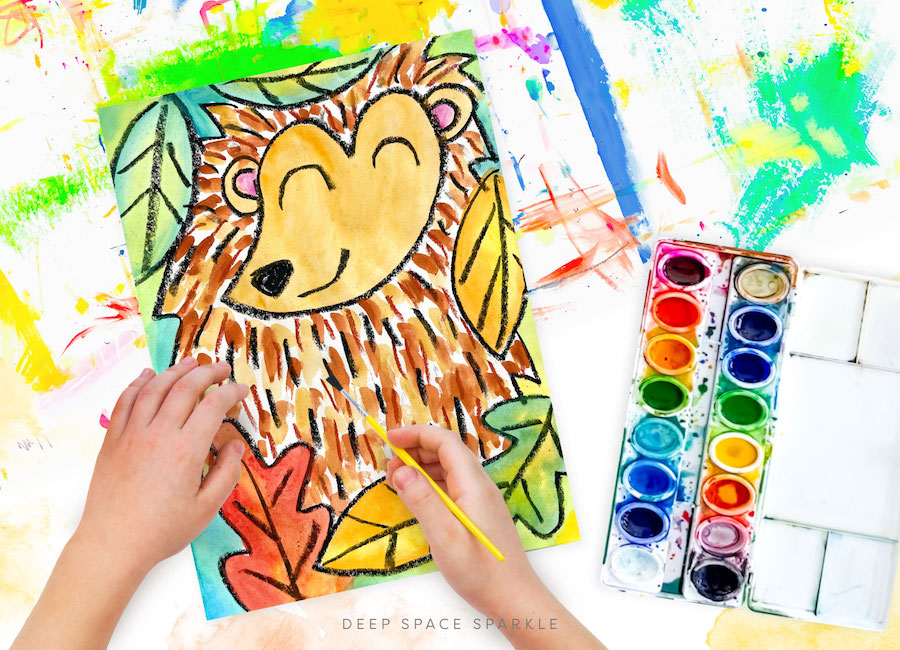
Tempera paint is by far (and I stress by far) the most essential paint to have in your classroom. I use it for more than 3/4’s of all my painting projects.
I love the Crayola Brand and I get the basic colors: black, white (more white than any other colors), primary and secondary colors, turquoise and brown. With these colors you can achieve most any color that you desire.
Other art teachers have found success using other brands and the truth is, I don’t think they vary too much. So order whichever brand offers the best deal.
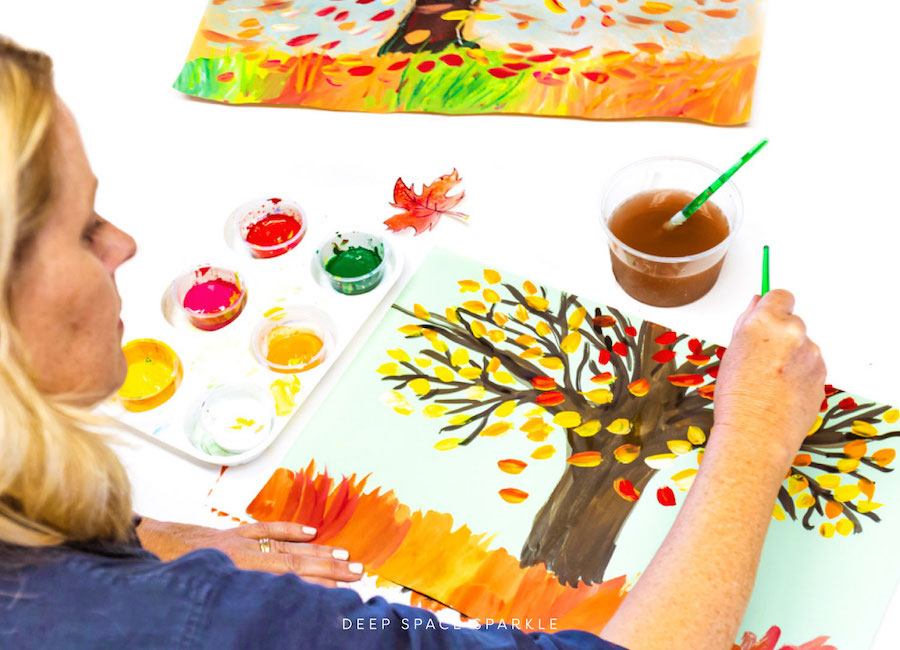
Distribution of Paints:
I like to distribute my tempera paints in 6-well plastic trays for projects that require my students to mix paints. I try to gauge how much paint the class will use because once you squirt the paint into the trays, it’s hard to save the left-overs.
Sometimes I will mix colors directly in the bottles and then squirt the new color into the tray. I think it helps give the painting project a color boost. Try adding a bit of white to the standard yellow; it takes the green tinge away making the paint so much prettier!
Tip: If you need to save the paint-filled palettes until the next day, place some plastic wrap on top. It should keep the paint relatively moist for up to 3 days.
When a project calls for general colors, I like to set plastic tubs of pre-mixed paints on the tables. This is my preferred method as I don’t waste paints. Even if the colors come straight from the bottle, it makes sharing paint and brushes much easier.
After the class is over, wipe the rim and place the plastic cover on. My paints will last 2-3 months with this method. Any longer and the paint will begin to smell.
Puck or Cake Tempera Paints
Puck tempera paints are a great time-saver. I use these paints when mixing is not a primary concern.
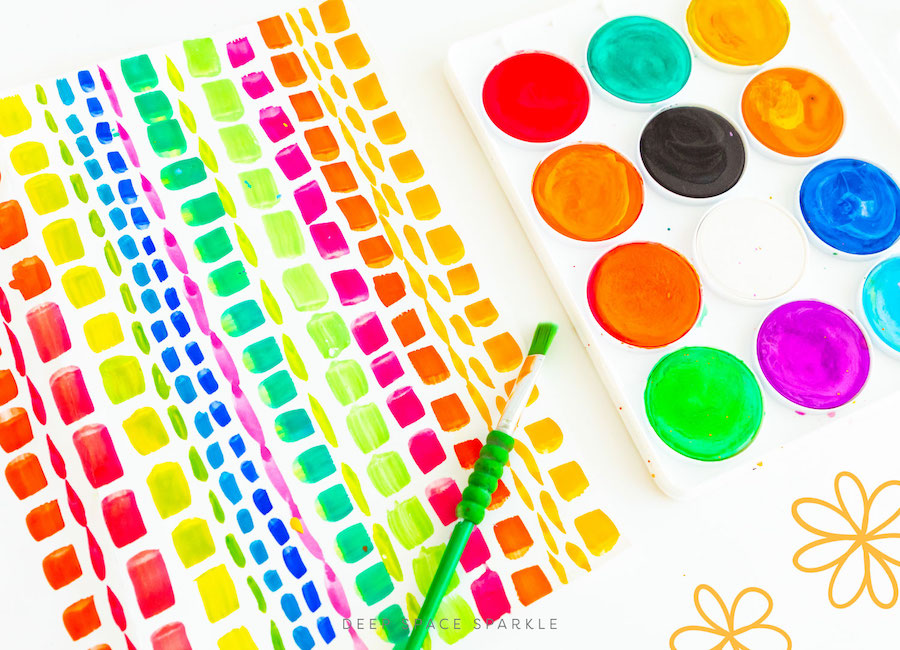
They are best used with projects that require a layer of paint but that’s it. Trying to mix cake tempera can be done but you need to swirl the brush around the paint for a long time in order to kick up enough color. Having said that, even if you aren’t mixing colors, you still need to swirl the brush around to get enough color on your brush. But when you do, the color is lovely to apply onto the paper.
Younger grades love working with cake tempera and the prep is so easy that I overlook the biggest drawback: a chalky finish. There isn’t much you can do about the finish but some teachers I know have applied a layer of gloss over top. Seem unnecessary when you could just use liquid tempera.
The best paper for tempera paints (liquid and cake): Sulphite Drawing Paper (I like Tru-Ray)
Specialty Paints
There are a lot of specialty paints out there that look pretty darn fun. I’ve tried quite a few and feel that most aren’t worth it. Here are the ones I’d recommend:
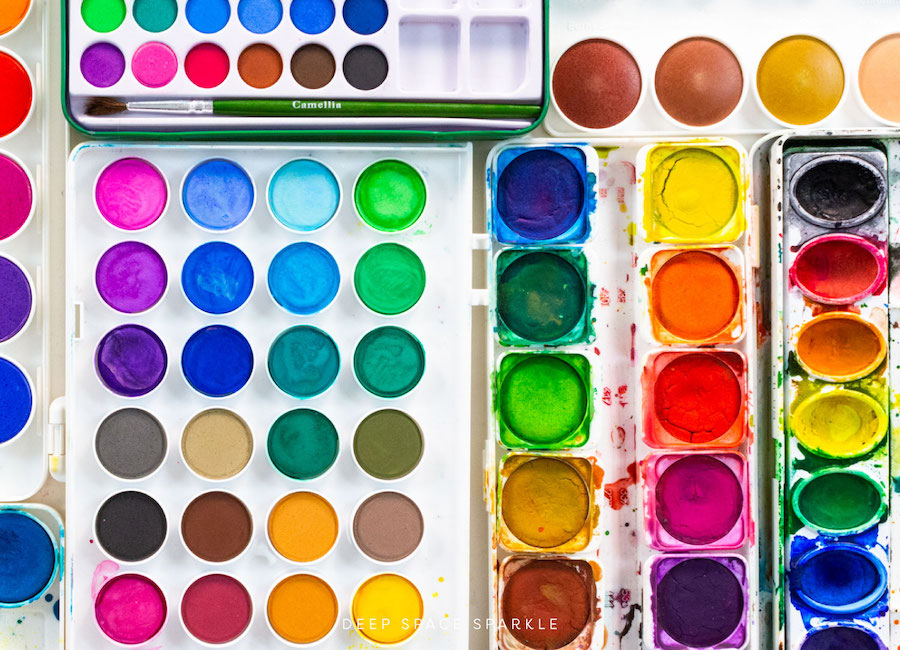
Sargent Art Metallic Tempera: I love, love, love the gold and silver version of these metallic paints. I wouldn’t bother buying the other colors as there isn’t much need. They are expensive, about $6 for an 8-oz bottle, but if you use them as an embellishment for a painting or collage project, you’ll be surprised at how long they can last. Even in a project that requires an entire surface be covered, like these Poinsettia Plants, you still won’t need more than 1/3 of the bottle for 2-3 classes.
Occasionally, I have purchased colored metallic paints like red or turquoise. I love these two colors as they are really a standout in some of the projects that I have done. The Cardinal in Winter is my favorite and you can see how beautifully the metallic blue paint works.
If you can afford to buy a couple of bottles, stick with gold and silver and give these a try. Lots of fun and the kids LOVE them.
Glitter Paint: I’ve purchased a couple different brands of glitter paint hoping for that magical formula but I’ve always been disappointed. The paint always ends up with a strange viscosity; a bit gluey and transparent. I’d pass on glitter paint in the tempera form although the liquid watercolor glitter paint is a bit better (but still doesn’t have the wow factor I was hoping for). Your best bet with glitter is the old shaker style glitter which you can apply on top of any paint surface, and it’s a lot more fun as well.
Pan Watercolor Paints: You may all know that I adore liquid watercolor paints and it’s really my go-to choice when it comes to any watercolor project. I’ve written a whole post on the virtues of liquid watercolor but I don’t often talk about pan watercolors. And there is a good reason for that; I don’t like ’em. Mixing cheap pan watercolors is frustrating for many kids; the colors get muddy, the pans are never clean and cleaning them is a pain. BUT they’re an important part of art education, so I must use them.
I’ve used the Prang brand ever since I’ve started teaching art and although they are probably as good as any other affordable paint set out there. My favorite is the Prang 24 cake watercolor set. I’ve used them for many projects, like these James Rizzi art projects, and the colors are fantastic. Maybe it’s because the palettes are brand new or perhaps it’s because the variety of colors makes it unnecessary to mix.
Fluorescent Paints: I bought a set of fluorescent paints last year. They were expensive; about $50 for six, 16oz bottles. Would I buy them again? Probably not. I did find having the pink and orange on hand was great as it’s hard to get a good vibrant pink and orange from mixing the standard tempera. Aside from these two colors, I didn’t think the other colors (yellow, green and blue) were of any great advantage to any of my projects. If you can order separately, get the pink and orange and then at least you will have the bright color in your paint arsenal.
Acrylic Paints
I rarely use acrylic paints in the classroom as I find them a bit troublesome to prep. Squirting into paint palettes is a bit messy and if you pour the paints down the drain, they have a tendency to clog the sink. Instead of palettes, you’ll need to use wax paper or rip a page from a magazine. And if you choose this method, children will need their own paint palettes. A bit of extra work but okay for special projects.
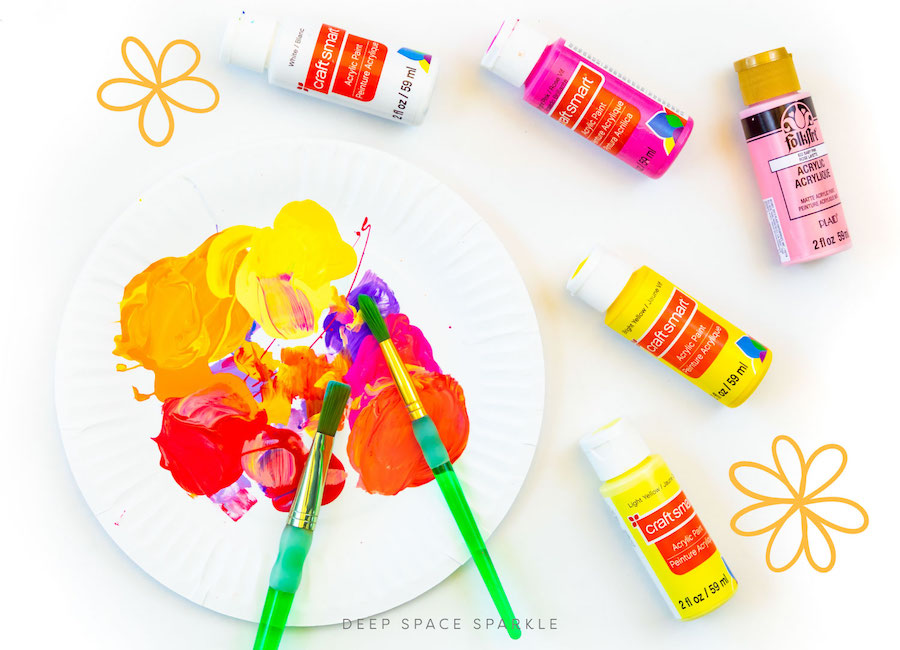
I have used acrylic paints instead of liquid tempera on papiér mache projects. This not only adds glossy but a bit of structure as well. When I use acrylic paints for this type of group project when color requirements are limited, I will squirt acrylic paint into individual tubs. Works great.
Children should wear smocks or else the paint will stain their clothes, although I have found that acetate (nail polish remover) will remove a few spots here and there. I do love the glossy, intense colors and have used them on canvas sheets.
Best paper for Acrylic Paints: For individual projects I use canvas boards or sheets. Regular sulphite paper is fine, too.
Have you found any other must-have paints? Please share what you have found!
Interested in a free download recommending the best art supplies needed or your classroom this school year? DOWNLOAD by clicking the yellow box below!
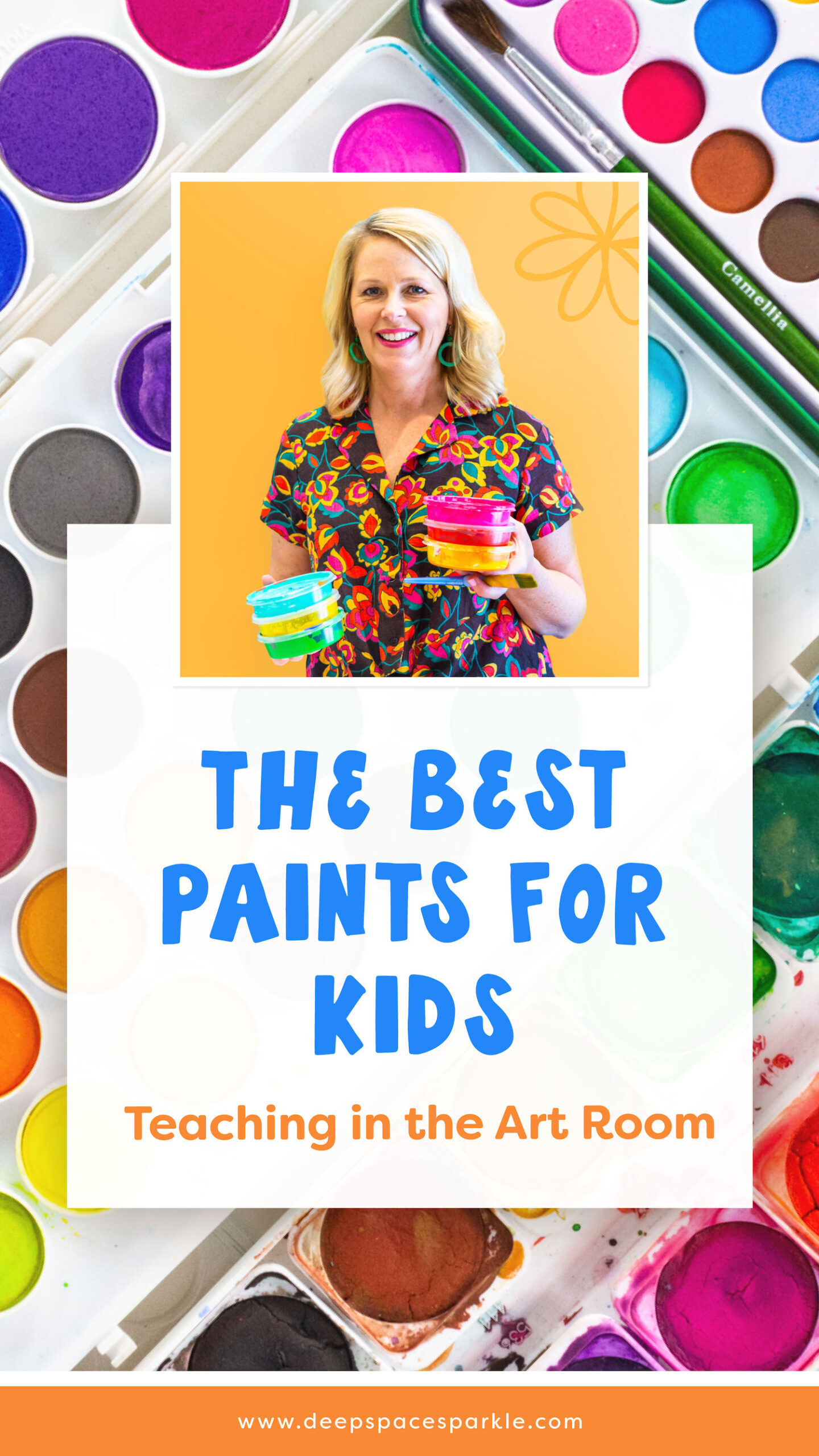

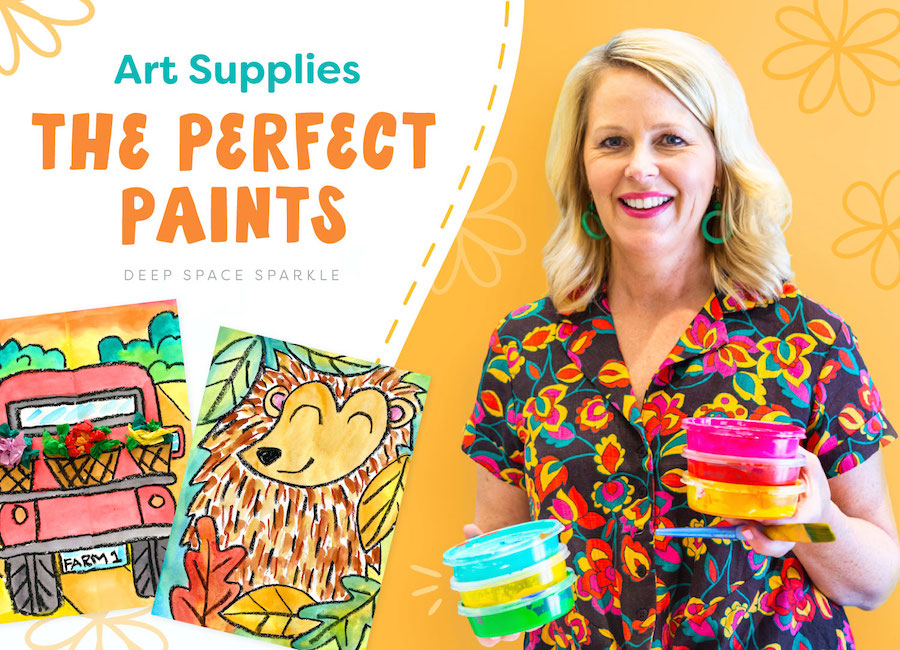











I’ve used Crayola watercolors and they are really vibrant. I think some of their sets have different rules for mixing colors which makes me wonder if it would confuse the students. I thinking it was something like mixing red orange and red violet to make a red, for example, but I can’t remember for sure.
I love the prang semi moist oval DOUBLE sets, really nice color selections, especially turquoise and magenta. Have tired other and still go back to prang.
That’s good to know. I was thinking of trying another double set. Glad you like them.
What are the paints in the first photo underneath the watercolors? Those colors are beautiful!
I love Blicks student grade tempera and Sargents liquid watercolors- I just ordered the Sargents Metallics- so I’m so glad you recommend them! Can’t wait to get messy! 🙂
The paints you are referring to came in an art kit for kids. It doesn’t have a brand name. I agree. Pretty colors!
I purchase mostly Sax Versatemp for tempera – good consistency and less expensive than Crayola, plus they are from School Specialty which is where I’m supposed to do my orders.
I also use a lot of acrylics, in particular for papier mache projects, clay (air dry clay is all I have), and plaster bandage sculpture. I am partial to Nasco’s Bulk-krylics. They are a school grade acrylic but the colors are pretty nice. I’ve aslo used Blick’s school acrylic and they are OK too. I do NOT like Chromacryl. The colors are wonderful but the paints are SO thick they are hard to get out of the bottles so there is a lot of waste, and they are also tougher for the kids to keep their brushes clean.
Phyl, what brand of air dry clay do you like to use? I tested several this summer but I’m not sure I’ve found the ‘holy grail’ yet!!
I use Reeve — it’s a palette with landscape colors. To mix, I’ll often have kids use a glazing technique.
I too use acrylics — liquitex or Reeve brand — I stretch the acrylics by having kids gesso the paper first — it’s fun and the paint goes on so smoothly. Sargent for liquid watercolor and Dick Bilck for tempera paint.
I also like the crayola tempera.
Have you ever tried the crayola tempera mixing mediums? Glitter, pearlescent and texture? Was thinking about trying them out this year.
Any ideas on how to preserve tempera paint on canvas? Polyurethane or something?
I order those every single year and my kids adore them. I have mixed them with other liquid paints besides tempera and get great results. The peralescent is generally the fave around here.
I am a HUGE fan on tempera cakes for my little ones…the do tend to stain my tables, though, when the kids push the paint along the sides of their papers! They love them because only THEY get to use them!!!
A good tip that I found works great is to add 2-3 drops of dishwashing soap to the paint when you dispendse it for the kids. Mix it in and it makes clean-up super easy without affecting the texture of the paint.
I’ve heard this tip before. Any help with clean-up is great. Does it change the consistency of the paint? More silky maybe?
I didn’t notice any difference in the paint.
Hello! First of all, thank you so much for your blog! I am a second year art teacher and have used so many of your tips and ideas to get started.
I had a question regarding watercolor…I know you said you hate pan watercolor and I am quickly starting to feel the same but I had a whole bunch donated to my art room this year so we are using them. I was wondering if you know any way to prevent them from getting sticky. The kids get the colors so wet, especially after a few class periods of use and then they just turn into a sticky mess pretty much forever. Any tips?
Hi Melanie,
I suppose there are some virtues to pan watercolors but you certainly hit upon one of the biggest annoyances! Sticky paints. Yuk. Surprisingly enough, that hasn’t been one of my problems but I certainly see it enough. Obviously, the student used too much water. One solution is to dry out the pan quickly. That means an open cover storage option. Just lay them on a table in all their open-face glory and let ’em dry out. But some never dry out completely and they are always sticky. Only solution is to toss them and stick in another oval. There is probably some scientific solution but well, I’m just not that intuitive.
Good luck and buy liquid watercolors.
Have a great second year!
I’m having trouble with Crayola’s washable tempera. It is not mixing well with other colors and is thick in the bottle, but only a thin layer seems to stick to the paper. I thought I didn’t shake them up well enough so I shook them like mad and it did not help. I’m considering dumping them into my art blender, mixing, then putting it back in the bottle.
I usually love Crayola, but have never ordered the washable kind before.
Does anyone have any tips?
Hi Susan,
This is an unusual problem. I’ve always used washable tempera and although it is thick in the bottle, I always add water to it until I get the consistency I want. I’m not sure why it is not sticking to your paper. It might be best to call customer service where you purchased the paint and see if you have a bad batch.
Thanks, Patty. I’ll try mixing them with water first, then call costumer service if it still doesn’t work.
Love your website!
My art room came with some paint that has probably been sitting on the shelf for a couple years. They smell clear the room terrible. I was wondering, what is the shelf life on tempera paint? Is there a way to avoid it going rotten or is it still usable?
I’m really not sure of the shelf life of tempera paints but if it smells, you probably want to discard it for the smell alone. You can call the manufacturer to see if they can replace it. I’m wondering if they have an expiration date on the bottle? Sometimes this happens to me when I mix my paint in tubs. They start to smell after awhile. I don’t bother with preservatives.
Watercolors… I have been using Yarka Semi-moist watercolor pan set of 12, for a bout $4 a tray from Dick Blick. They are vivid, and worth the upgrade from a prang or Carola set. Our elementary art teacher discarded the Crayola ones after trying these.
Cleaning the pans… if you use a tiny stream of warm water rinsing over the pan for about 4 seconds, shake out the excess water/paint, and do it again.. Success! It is clean… as long as the black was on the lower end of things.
Dear Patty,
I have wanted to thank you for a long time! Your site is amazing and has helped me so much in the art room! As far as glitter paint goes, I feel disappointed in glitter paint, too. I found if I watered down glitter glue in cups and provide a brush for the kids, adding glittery details is better than the glitter paint.
Thanks again!
Susie
Yes, glitter paint sounds so wonderful until you actually use it. Thanks for the email!
New art teacher here. I’m curious to know if you purchase the large gallon jugs of paint or if you purchase the smaller 16 oz bottles at the beginning of the year? Thanks!
Hi Kristi, I purchase the regular 16oz size.
Hi, love the information the site offers. When using watercolor with the kids, they seem to use way too much water, and the colors run and make a mess. How do you get them to use enough water, but not too much? Any suggestions would really be appreciated. Thank you!
I have made over 900 papier mache pigs with my students each year for 10 years. At some point, Crayola started making Artista II Washable tempera, now just called Crayola Washable Tempera. Not totally thrilled with the opacity– I mix a bit of white in with the orange and yellow colors so the newspaper doesn’t show through. And if the paint is too thick it cracks when it dries. It’s more expensive, too, but I buy it by the gallon. The up-side is that it completely washes out of clothing, even white t shirts. The old tempera paint would stain no matter what. When I started switching over to Washable tempera, sometimes I’d mix a color and use a bit of the regular tempera, which would turn the paint into silly putty. So I’ve had to be very careful when mixing to only use the washables together. The slippery quality of this paint might be the reason Susan is having trouble getting it to stick. Sometimes you need 2 thin coats.
I love the Yarka pan water colors. Your ideas are inspirational. I teach kindergarten and I have used and adapted many of your ideas. Thank you for sharing your wealth of experience and creativity.
So, am I a horrible art teacher if I use paper plates to put my tempera paints on? I use it sparingly and give students more if they absolutely need it. The clean up is so fast…into the garbage. It never seems like I have time to wash trays between classes or at the end of the day. And it seems like any extra paint that may be thrown would be washed down the sink using palettes. (Not a lot of paint, just the very end, dried up smear)
Feeling a little wasteful..but saving time.
haha…no, not at all! Sometimes you have to pick the lesser of two evils. Paper plates work great and I agree, a huge time-saver. Don’t feel guilty.
Hi Patty… I am Tempera Gloss for my paper Mache masks and when used over the red or black paint it runs and ruins the whole mask! Why would the glaze that is supposed to be for Tempera do that? Any ideas?
Also my Acrylic in jugs smells really bad, but is working O.k. on my plaster-craft masks… should I throw it out? Thanks!
Jane,
Are you sure your jugs of paint are acrylic? They may be tempura which is made from organic materials which eventually spoil/stink. I learned this the hard way – bought a bunch of gallon jugs thinking they’d last forever… and then they started stinking real bad. Since acrylics are synthetic based they shouldn’t go stinky. I threw mine out, I just couldn’t hang.
🙂 Aim
Any suggestions for containers for tempera paints? What kind of containers are the clear plastic one’s in the photo above? I hate throwing away paint!!!
I’ve found the best way to seal and gloss paint on 3D artworks (ceramics, paper mache) is to spray with an acrylic coating such as Krylon Crystal Clear. This is the same stuff usually used on chalk pastels, but I’m amazed how well it works on paint. Just be sure to spray when kids are out of the room and with the windows UP as it’s pretty “fummy.”
I’m in my first year of teaching art and I find myself spending a LOT of money on supplies and there is a lot of waste. I’ve been using acrylic paints mostly on nice water color paper which eats up most of my budget. I read that you love tempura paints. Do you get the same vibrant results as acrylics? Is there a time that you DO use acrylics? Is there a paper that you recommend that might be a little more cost effective? Also, have you ever used the tempera paint cakes? If so, do you like them or prefer them over the liquid tempera paints? And do you have your kids share paints or do they each get their own palette or plate? Thanks for all your valuable informations:)
These are GREAT questions! I just edited this post to include answers to your questions. I hope you find it helpful. Also, I go into great detail in my e-course Teaching Art 101. Have you ever considered taking this course? It might be something you will find helpful. Here is a link: https://www.deepspacesparkle.com/teaching-art-101-information-page/
any ideas on how to recycle very used tempera paint cakes?
I pretty much use my cakes until they are completely gone! If they are crumbling, I would discard and buy a replacement.
Suzanne, I use old tempera cakes, the crumbly kind, as a watercolor wash. I put the chunks of broken tempera into a cup with water, swirl it around, let it sit a bit, and voila, light watercolor paint. This saves me when the kids are painting a sky with blue, they don’t use all the paint in the little trays. Works great for a watercolor resist as well.
I use the Prang 16 pan sets. I ditch the white when I first get them and add red-violet. Next I re-arrange them so that warm colors are on one side and cool on the other, following the color wheel, with magenta and turquoise as “bonus” colors, and black and brown on the end as the neutrals. And there’s my warm-cool-neutral color scheme. I keep replacing them until the trays literally fall apart (duct tape to the rescue). Also, the first thing that my students learn is that we NEVER close the water colors. They get stacked in two different directions in a wire basket. It really helps with drying. I used the old 8 pan trays to pair the complementary colors, with an empty space in between to separate them.
Glitter Paints: As a manufacturer of School Paints I thought I would explain why glitter paint is like it is.
If you use normal tempera paints with Glitter in the formulation the glitter particles get covered in paint so you don’t see any sparkle. This make the paint pointless as it is all about the sparkle.
This is why you get that transparent type of paint you mentioned above but with glitter particles in it.
Hope this is helpful…..
Also if you are looking for a fine art painting experience for kids see our “Super Tempera” with bright true and bold colours. Real reds, jet blacks and strong colours.
http://www.faspaints.com/super-tempera.html
Thanks
Tony
Would love some art teacher input…can you describe your paint clean up procedure? Do you simply wash the brushes and palettes in the sink with running water? Is it safe to clean that way or should all paint left on the palettes be wiped out and thrown in the trash? Do you use special brush cleaner? If safe to rinse in the sink, do you rinse out old tempera bottles and recycle them or do you have to just throw them away? I’m very confused about proper clean up techniques and want to be as environmentally friendly as possible, but I’m finding that challenging!
I found that everyone has their way to clean up and you should try to find what works for you by experimenting. I use watercolor and tempera paints and just rinse my brushes and palettes under water. Is it safe? Yes.
No brush cleaner. Tempera paint is water based.
What paint are you using? Acrylics require a different clean-up.
Good article about paints I noticed you ranked tempera paint at the top as one of the best paints to use. A website I would check out that offers activities and a wide selection of tempera paint along with other types of paint, arts and crafts at affordable prices is Discount School Supply.
Thank you for all this information! I just wanted to share a little warning….I recently ran out of my go-to washable tempra paint (don’t have the bottle with me but it’s a major school-supply brand) and had to find some white in a hurry. I ended up getting a bottle at Hobby Lobby (craft store) as it was all I could find. But it had a TERRIBLE paint smell. It was a non-toxic paint, but that smell permeated the art room for days and brought the “what smells?” comment at least a hundred times! So beware when picking up paint from big box stores! They may be washable and non-toxic, but they can have a very strong odor!
I am currently using crayola tempera paint and typical easel paper. After the paintings dry- they are becoming so crumbly and stiff that I can even fold them to put into folders for the children. What do you think is the problem- the paint or the paper??
This type of crumbling problem is the paint. Tempera paint generally dries to a matte finish. It’s not meant to fold so I would advise against that. Many artists use acrylic paints and love how they feel. While acrylic paint is great for adults, they aren’t used that often in elementary school. I used some but mostly for older grades. They are a bit more expensive and require a different prep set-up. Having said that, it might be worth it for you.
The thing to remember is that its not always necessary to provide supplies start act like expensive art supplies….teh kid’s will love tempera paint so don’t worry about the crumbling.
This is great information and a relief to find your site!! I teach art and am often frustrated by the cheap quality of supplies available for children. Budgets are always woefully limited. But this info is helpful!!! thank you so much!!!!
“Flesh”- I’m hoping flesh is a set of a dozen colors. If not, whose flesh are you referring to? It should be called something like “apricot” or “beige.”
I LOVE watercolor painting!! We draw with black crayon and paint in our master pieces!! Some of my younger kids just can NOT keep our trays clean…I mean with mixing paints. Is there an easy way to help this? Thank you for everything!!
Also, How do you have the kids clean up?
Trying to waste less Liquid Tempera this year :). When you talk about the plastic tubs, “When a project calls for general colors, I like to set plastic tubs of pre-mixed paints on the tables”– what do those paint containers look like and do you have a brand you recommend? Like a tray of multiple plastic containers with lids that hold the paints you’ll use for each table? Thank you!!
I love it!
Thank you very much for your ideas.
I love it!
Thank you very much for your ideas.
So disappointed that crayola no longer sells their refill pan colors. Happy to hear you like prang watercolors…I think they still carry refills.